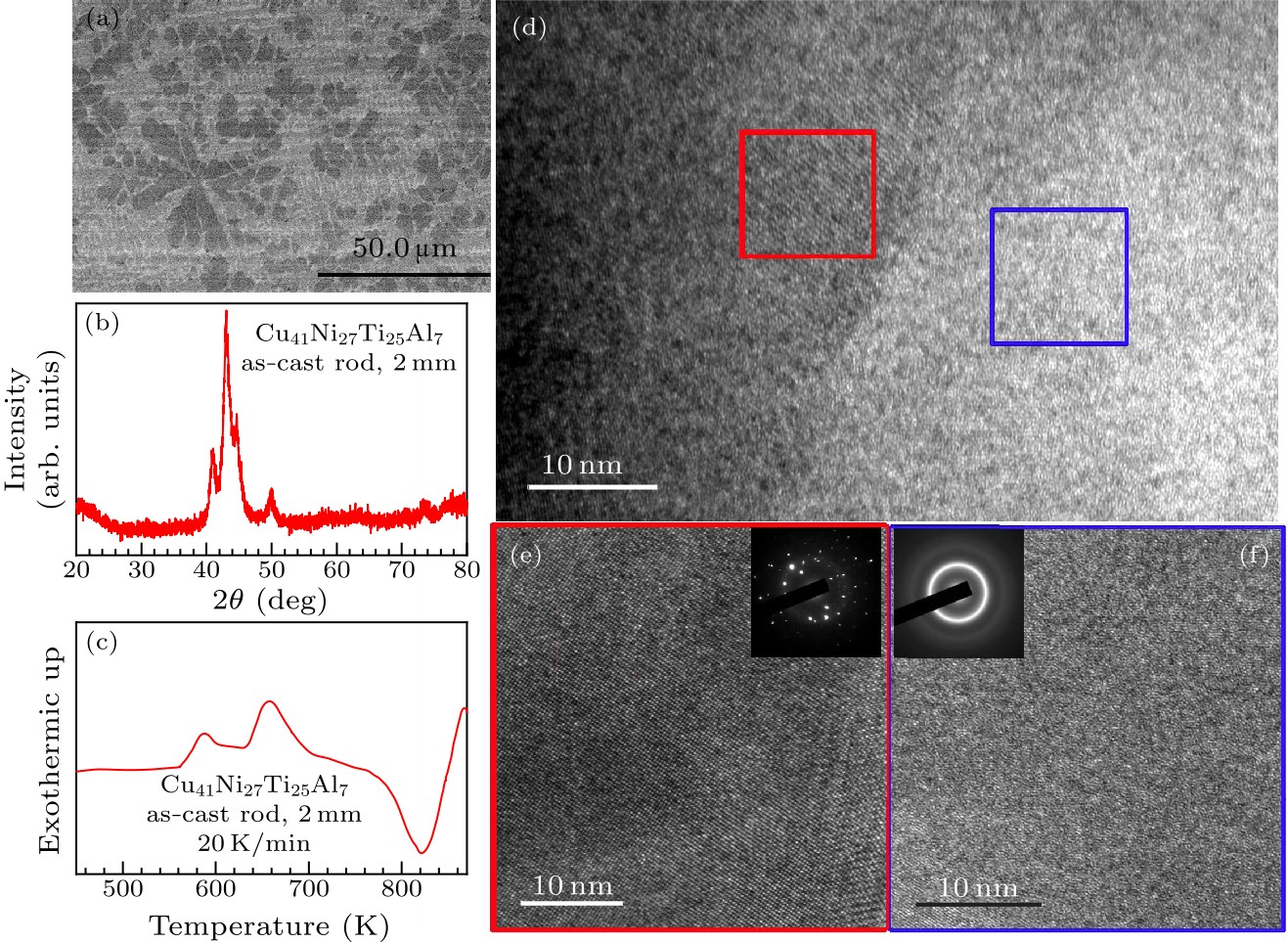
Fig. 1. (a) SEM image of the cross section of Cu$_{41}$Ni$_{27}$Ti$_{25}$Al$_{7}$ with the contrast that has been reversed and increased to differentiate the two phases. (b) XRD pattern and (c) DSC results of Cu$_{41}$Ni$_{27}$Ti$_{25}$Al$_{7}$. High-resolution TEM images for (d) the interface between the two phases, (e) the crystal phase, and (f) the glass phase, with their corresponding diffraction patterns shown in the insets.

Fig. 2. True stress-strain curves of Cu$_{41}$Ni$_{27}$Ti$_{25}$Al$_{7}$ rod under (a) compression and (b) tension mode at room temperature.

Fig. 3. (a) SEM micrographs for the Cu$_{41}$Ni$_{27}$Ti$_{25}$Al$_{7}$ rod after compression. (b) Magnification of the oval region indicated in (a), (c), and (d) showing the magnification of rectangle regions indicated in (b).
| [1] | Peker A and Johnson W L 1993 Appl. Phys. Lett. 63 2342 | A highly processable metallic glass: Zr 41.2 Ti 13.8 Cu 12.5 Ni 10.0 Be 22.5
| [2] | Wang W H 2012 Prog. Mater. Sci. 57 487 | The elastic properties, elastic models and elastic perspectives of metallic glasses
| [3] | Greer A L 2011 Nat. Mater. 10 88 | Damage tolerance at a price
| [4] | Ding S, Liu Y, Li Y, Liu Z, Sohn S, Walker F J and Schroers J 2014 Nat. Mater. 13 494 | Combinatorial development of bulk metallic glasses
| [5] | Chen M W 2008 Annu. Rev. Mater. Res. 38 445 | Mechanical Behavior of Metallic Glasses: Microscopic Understanding of Strength and Ductility
| [6] | Şopu D, Scudino S, Bian X L, Gammer C and Eckert J 2020 Scr. Mater. 178 57 | Atomic-scale origin of shear band multiplication in heterogeneous metallic glasses
| [7] | Chen G, Cheng J L and Liu C T 2012 Intermetallics 28 25 | Large-sized Zr-based bulk-metallic-glass composite with enhanced tensile properties
| [8] | Xiong J, Liu Y, Yu A, Liu B, Yu K, Huang X and Yang X J 2018 J. Alloys Compd. 741 1212 | Microstructure and mechanical properties of Ti48Zr18V12Cu5Be17 bulk metallic glass composite
| [9] | González S, Louzguine-Luzgin D V, Perepezko J H and Inoue A 2010 Intermetallics 18 859 | Novel Mg46Li19Cu25Y10 multiphase composite containing amorphous and ductile phase
| [10] | Hays C C, Kim C P and Johnson W L 2000 Phys. Rev. Lett. 84 2901 | Microstructure Controlled Shear Band Pattern Formation and Enhanced Plasticity of Bulk Metallic Glasses Containing in situ Formed Ductile Phase Dendrite Dispersions
| [11] | Qiao J W, Jia H L and Liaw P K 2016 Mater. Sci. & Eng. R 100 1 | Metallic glass matrix composites
| [12] | Hofmann D C, Suh J Y, Wiest A, Duan G, Lind M L, Demetriou M D and Johnson W L 2008 Nature 451 1085 | Designing metallic glass matrix composites with high toughness and tensile ductility
| [13] | Byrne C J and Eldrup M 2008 Science 321 502 | Bulk Metallic Glasses
| [14] | Launey M E, Hofmann D C, Suh J Y, Kozachkov H, Johnson W L and Ritchie R O 2009 Appl. Phys. Lett. 94 241910 | Fracture toughness and crack-resistance curve behavior in metallic glass-matrix composites
| [15] | Ding D, Zhang Y Q and Xia L 2015 Chin. Phys. Lett. 32 106101 | Magneto-Caloric Response of a Gd 55 Co 25 Al 18 Sn 2 Bulk Metallic Glass
| [16] | Pauly S, Das J, Bednarcik J, Mattern N, Kim K B, Kim D H and Eckert J 2009 Scr. Mater. 60 431 | Deformation-induced martensitic transformation in Cu–Zr–(Al,Ti) bulk metallic glass composites
| [17] | Hofmann D C 2010 Science 329 1294 | Shape Memory Bulk Metallic Glass Composites
| [18] | Pauly S, Liu G, Wang G, Kühn U, Mattern N and Eckert J 2009 Acta Mater. 57 5445 | Microstructural heterogeneities governing the deformation of Cu47.5Zr47.5Al5 bulk metallic glass composites
| [19] | Zong H T, Ma M Z, Zhang X Y, Qi L, Li G, Jing Q and Liu R P 2011 Chin. Phys. Lett. 28 036103 | Formation and Compression Behavior of Two-Phase Bulk Metallic Glasses with a Minor Addition of Aluminum
| [20] | Chu C L, Chung C Y, Lin P H and Wang S D 2004 Mater. Sci. & Eng. A 366 114 | Fabrication of porous NiTi shape memory alloy for hard tissue implants by combustion synthesis
| [21] | Szuecs F, Kim C P and Johnson W L 2001 Acta Mater. 49 1507 | Mechanical properties of Zr56.2Ti13.8Nb5.0Cu6.9Ni5.6Be12.5 ductile phase reinforced bulk metallic glass composite
| [22] | He G, Eckert J, Löser W and Schultz L 2003 Nat. Mater. 2 33 | Novel Ti-base nanostructure–dendrite composite with enhanced plasticity
| [23] | Han J H, Kim K B, Yi S, Park J M, Sohn S W, Kim T E and Eckert J 2008 Appl. Phys. Lett. 93 141901 | Formation of a bimodal eutectic structure in Ti–Fe–Sn alloys with enhanced plasticity
| [24] | Abdeljawad F, Fontus M and Haataja M 2011 Appl. Phys. Lett. 98 031909 | Ductility of bulk metallic glass composites: Microstructural effects
| [25] | Abdeljawad F and Haataja M 2010 Phys. Rev. Lett. 105 125503 | Continuum Modeling of Bulk Metallic Glasses and Composites
| [26] | Wu Y, Ma D, Li Q K, Stoica A D, Song W L, Wang H and Wang X L 2017 Acta Mater. 124 478 | Transformation-induced plasticity in bulk metallic glass composites evidenced by in-situ neutron diffraction